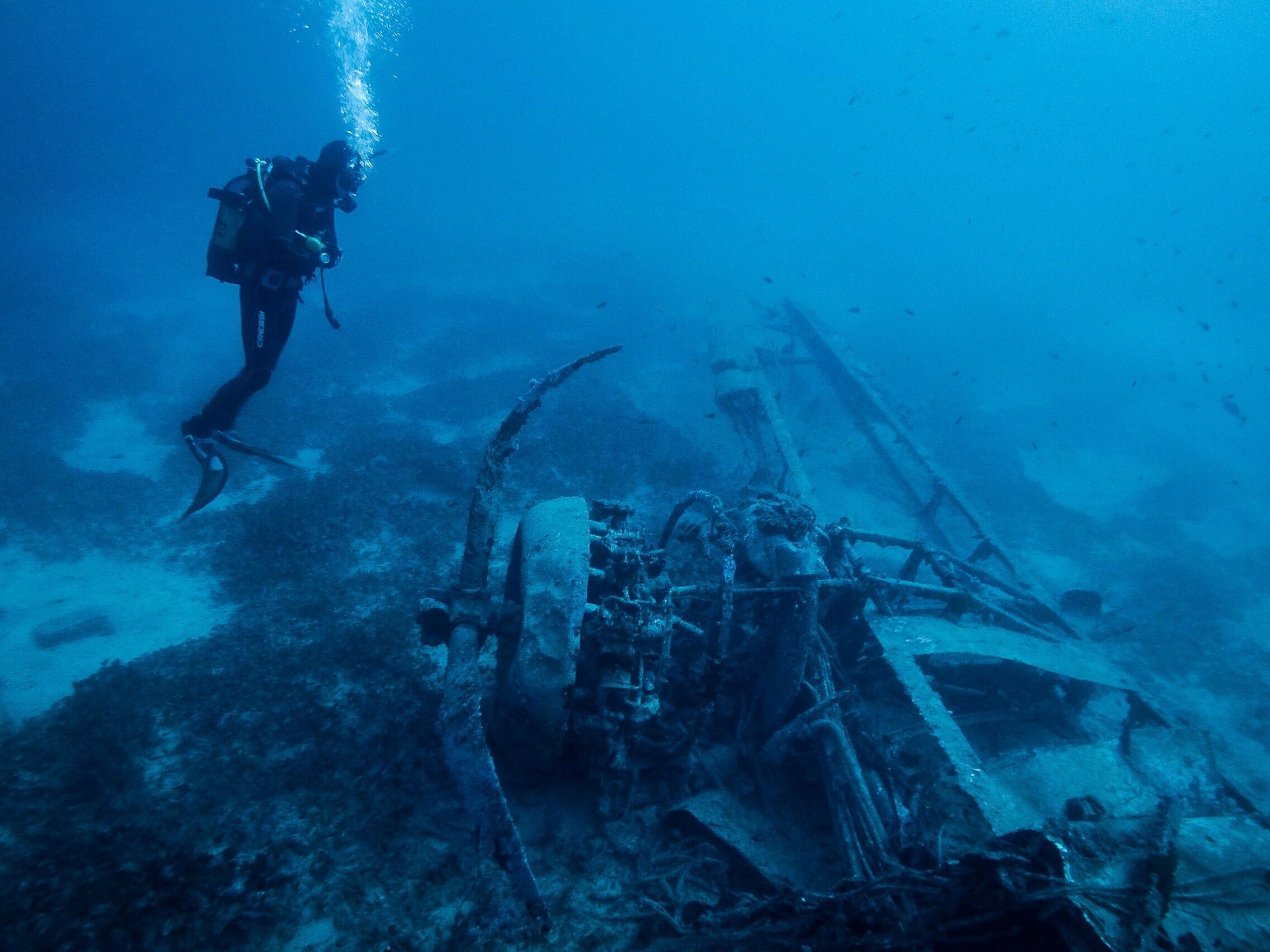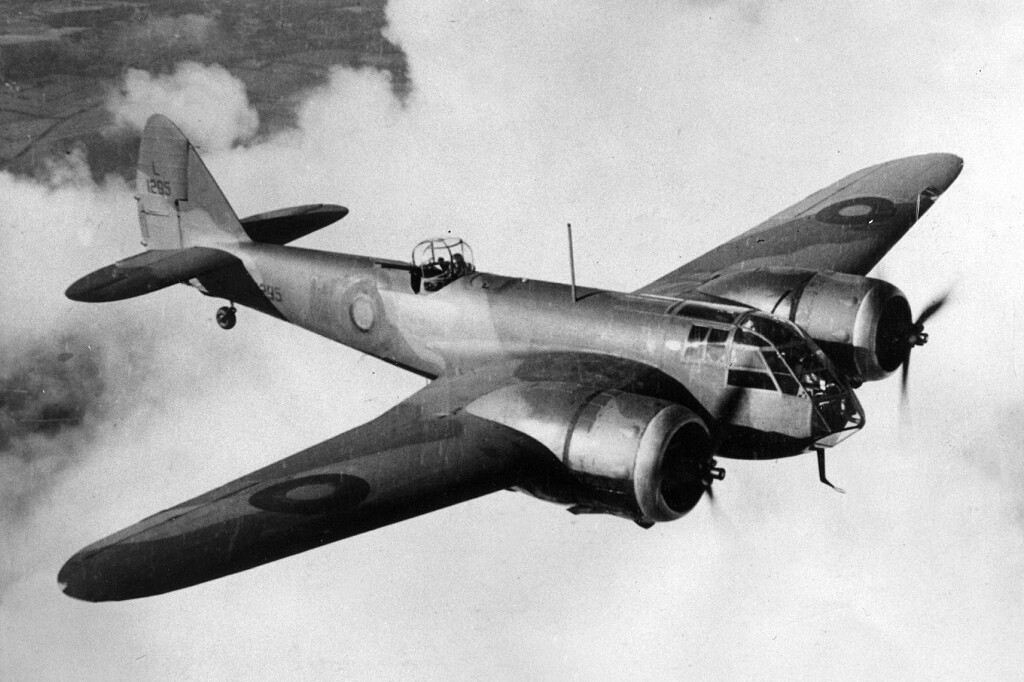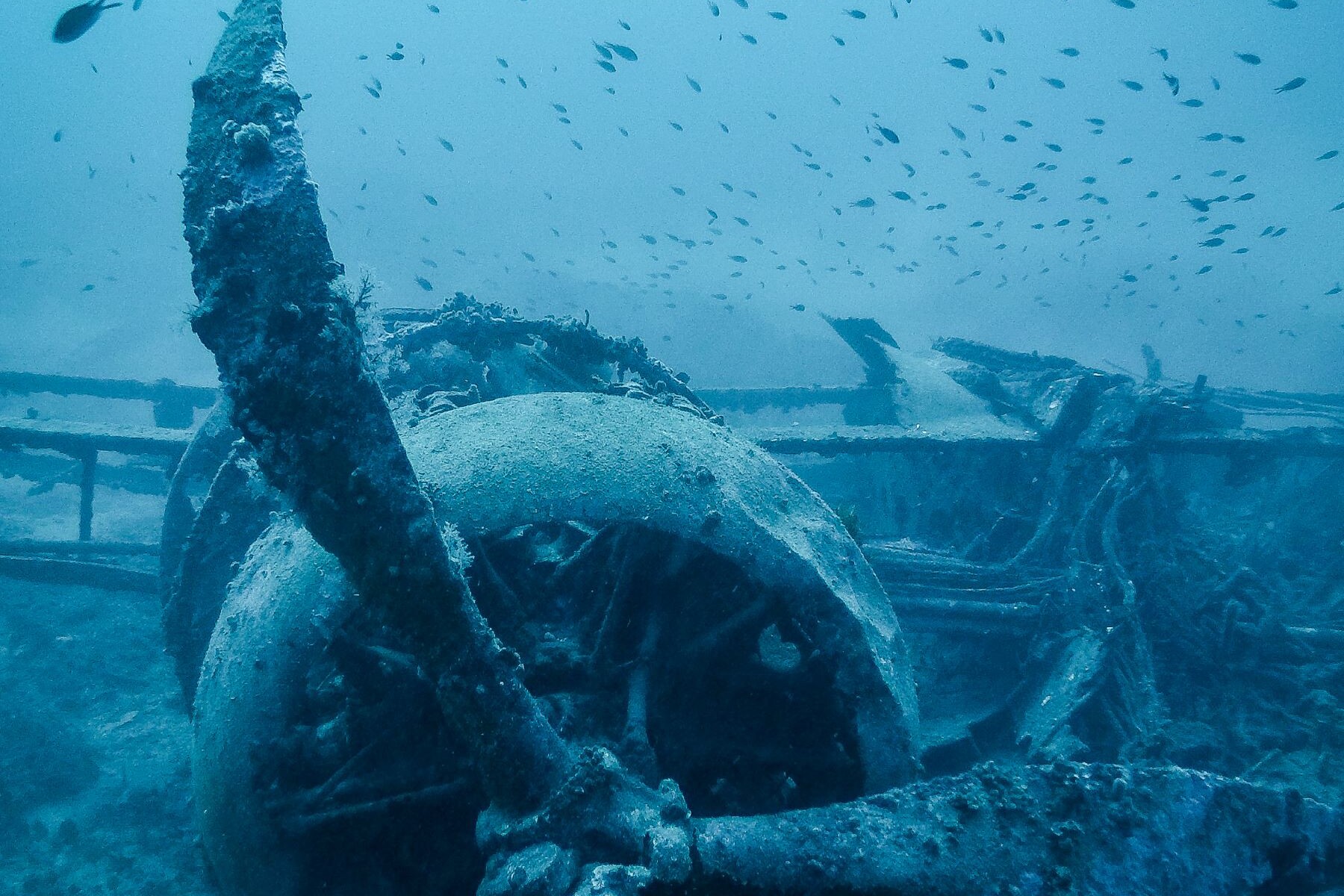Mosquito Fighter Bomber wreck
The Mosquito Fighter Bomber wreck, located near Malta, offers a unique and historically rich diving experience. Known as the De Havilland Mosquito, this British twin-engine, two-seat multipurpose aircraft primarily served as a fighter-bomber during its operational period. Remarkable for its construction, the Mosquito was predominantly made of wood, except for its aluminium tail, a feature that made it stand out among other aircraft of its era.
The wreck’s history is marked by a tragic incident on March 26, 1949, when the aircraft, during a mail run, experienced issues with its starboard engine shortly after take-off. Attempts to return to Hal Far airfield were unsuccessful, leading to its crash into the sea. Today, the wreck lies upside down at a depth of approximately 40 meters, about 500 meters off the coast of Delimara Point on the east side of Malta. The site is characterized by strong currents and is recommended for experienced divers.
Over time, the wooden parts of the Mosquito have significantly decayed, leaving behind a twisted metal frame and a mass of cables between the two intact engines. The aluminium tail is mostly buried in the sand, surrounded by miscellaneous metal parts. The starboard engine still has its propeller attached, offering a glimpse into the aircraft’s structure and design.
The site’s average depth is around 42 meters, making it a deep boat dive. Divers visiting the Mosquito Fighter Bomber wreck can expect to encounter an intriguing piece of World War II history, set against a backdrop of sandy seabed and small nearby reefs
Airplane description:
The de Havilland Mosquito, a British multi-role combat aircraft of World War II, stands as a remarkable example of innovative design and versatility. Known as the “Mossie,” this twin-engine aircraft was originally conceived as an unarmed fast bomber. However, its role evolved significantly during the war, encompassing a wide range of functions such as a tactical bomber, night fighter, pathfinder, day or night fighter, fighter-bomber, intruder, maritime strike, and photo-reconnaissance aircraft, mail plane.
Developed by de Havilland, the Mosquito’s design was influenced by earlier high-speed aircraft like the DH.88 Comet racer and the DH.91 Albatross airliner, which pioneered the composite wood construction used in the Mosquito. This construction not only saved weight but also simplified production and reduced construction time. The wooden monocoque construction was crucial, especially considering wartime shortages of metals like aluminum and steel.
The Mosquito was known for its exceptional speed, altitude, and range, thanks to its construction primarily of plywood with a balsa wood core. It achieved a maximum speed in excess of 400 miles per hour and a range of more than 1,500 miles with a 4,000-pound bomb load. The aircraft’s original armament included four .303-caliber machine guns and four 20-mm cannons, all firing through the nose.
The versatility of the Mosquito was further exemplified in its night fighter variants, which evolved with better radar suites and were equipped with a powerful 4 x cannon battery. These aircraft played a crucial role in night operations, relying heavily on onboard technology for enemy detection and engagement.
Additionally, the Mosquito was used for psychological warfare, targeting housing for factory workers to disrupt their sleep and consequently their productivity. One of its most notable missions included bombing the Gestapo HQ in Oslo, covering a remarkable distance of 1,100 miles.
Several variants of the Mosquito were produced, each tailored for specific roles. The photographic reconnaissance variants like the PR.Mk I and PR.Mk IV were equipped with cameras for intelligence gathering. The fighter-bomber variant, FB.Mk VI, was a definitive form used in day/night intruder raiding roles. The dedicated bomber variants like the B.Mk IV and B.Mk XVI were capable of carrying substantial bomb loads, contributing significantly to Allied bombing campaigns.
The Mosquito served with distinction in various theatres, including the European, Mediterranean, Italian, Southeast Asian, and Pacific theatres, operated by forces such as the Royal Air Force and the Royal Australian Air Force. Its legacy continued into the 1950s before being replaced by more modern jet-powered aircraft like the English Electric Canberra.
In summary, the de Havilland Mosquito was a testament to innovative design and adaptability, proving to be one of the most successful and versatile aircraft of World War II. Its use of non-strategic materials, exceptional performance, and multi-role capabilities made it an indispensable asset in various combat roles
Bristol Blenheim Bomber wreck
The Bristol Blenheim Bomber wreck near Malta is a significant dive site for divers, offering a unique opportunity to explore a piece of World War II history. This light bomber aircraft, built by the Bristol Aeroplane Company and operated by the British Royal Air Force, met its fate during a mission to Kefalonia, Greece. On December 13, 1941, it was attacked by an Italian enemy aircraft, causing damage to its port engine. The pilot had to ditch the plane in the sea near Malta, and fortunately, the crew survived with minor injuries.
Located about 500 meters off Xrobb l-Ghagin on the east coast of Malta, the wreck lies upright on a seabed of sand and small reefs at a depth of 42 meters. It is a challenging dive site due to its depth and the occasional strong currents.
Notable features of the wreck include mostly intact wings and radial engines. The starboard engine still has a bent propeller, while the port engine propeller is missing. The cockpit cover is also absent, and the rear fuselage has broken off, lying a few meters away from the main wreckage, upside down and mostly buried in sand.
The Bristol Blenheim Bomber dive site is best suited for advanced divers. It requires boat access due to its offshore location. Divers should be aware of the challenging conditions and ensure they have the appropriate level of experience and certification for such a dive.
Builder: Bristol Airplane Company.
The boat:
Each and every dive trip on our boat includes the following extras:



